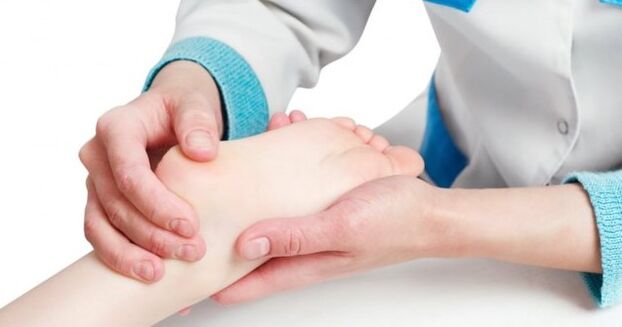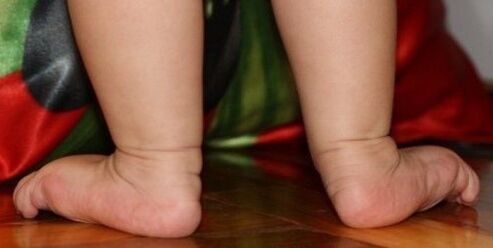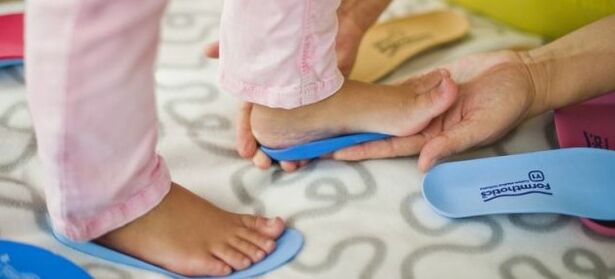Leg development deviations have about 40% of babies under 4.5-5 years of age.In most situations, children are diagnosed with deformation of valgus.With this pathology, the child's foot is flat and seems to fall inward, each other.The outer sides of the legs are slightly raised.If you look at the baby's feet from above, they form the letter H.

Valgus deformation of the foot in children - causes
The deviation in question occurs due to the underdeveloped connections in the legs.Under the influence of the weight of the body, they deform, the bones are displaced and bending.The Valgus children's foot is formed for many reasons that are conditionally divided into 2 groups:
- congenital;
- Acquired.
Congenital valgus deformation of the foot
The problem develops during the period of intrauterine formation of the limbs of the fetus.Flat volgus cloc is due to the incorrect location and bone growth.It is rarely bent against the background of intrauterine damage and joint dysplasia.Valgus deformation of the foot in children of newborns is diagnosed immediately after birth or during the first months of the baby's life.At this point, it is easy to adjust the shape of the foot, restore its height and make proper turns.
Acquired deformation of strain
This type of pathology occurs for external reasons affecting the musculoskeletal system.At first, Valgus's deformation in children is not too noticeable.The pronounced signs of the problem are observed at the age of 10-12 months when the baby tries to walk alone.Flat Valgus foot in a child of the acquired type develops for the following reasons:
- unobstrunce;
- Weakness of connective tissues;
- Severe infections transferred to an early age (bronchitis, pneumonia, acute respiratory viral infections, etc.);
- intrauterine muscle hypotrophy;
- rickets;
- Myodistrophy;
- polio;
- cerebral palsy;
- Polyneuropathy;
- Mechanical injuries and fractures of the limbs with long -term wearing of gypsum dressing;
- obesity;
- The baby is too early setting of the legs, premature trying to teach him to walk;
- wrong choice of shoes;
- Little mobility;
- Body deficiency in the body;
- unbalanced, scanty meal;
- Endocrine diseases.

Signs of valgus foot in children
The early symptoms of the disorder described are visible closer until the first year of the child's life.Parents notice that the baby is not based on the entire leg while walking, but only on the inside.The differences between changed legs and healthy legs are clearly shown in the photo below.The signs of pathology depend on the degree of deformation of the valgus of the foot in children:
- The light stage is characterized by the leveling of the legs without a significant leg of Parubartur.The angle of ankle deviation from a straight line, perpendicular heel, is up to 15 degrees.
- Valgus deformation of the foot in children of moderate weight is also accompanied by leg leveling, but they are dotted by 15-20 degrees.
- A severe degree of disease combines pronounced flat legs and a large angle of ankle deviation-20-30 degrees.
- An extremely heavy stage is characterized by a strong flattening of the vault of the legs.The ankles of the Minabantur exceed an angle of 30 degrees.
Non -specific symptoms of defect development:
- clumsy, stirring gait;
- fatigue during running and active games;
- unpleasant sensations in the area of the legs;
- The mood, the irritability of the baby.
Valgus deformation of the foot in children - treatment
Therapy methods are selected individually for each child in accordance with the degree of pathology.There are 2 options that adjust the deformation of the legs with a flat valgus can be done not by surgical and operational methods.In the first case, therapy involves wearing special orthopedic insoles and shoes, massage, physiotherapy exercises.Surgical intervention is very rare (approximately 7% of children) when the standard approach does not work or the disease is already diagnosed in a severe stage.
Orthopedic shoes for children with Valgus deformation
The boots and sandals for the child with the problem under consideration are made only for ordering.Valgus deformity orthopedic shoes are made according to separate Mittit or accurate measurements that make the straight.It is undesirable to buy such products yourself.The mass production of shoes is carried out according to the average parameters, which do not correspond to the specific angle of deviation and leveling of the legs.

Using a pair of sandals or boots, Valgus' foot is not adjusted - treatment involves long -term wear.Leg growth and gradual restoration of their shape requires timely replacement of shoes.You cannot buy it for the future or wear small size.The baby's legs should be strictly fixed at the bottom of the lower leg, heel and sock.
Valgus insoles deformation of the foot in children
These accessories are made, such as shoes, strictly individually.Proper treatment of valgus deformation on the foot goes into several stages from complex to simple.The size, the shape of the spinner must be selected according to the degree of leveling of each leg and the angle of its deviation.Mild deformation of the valgus of the foot in children is quickly adjusted, 3-5 pairs of devices examined will be required.With medium and severe diseases, insoles will often need to be changed for several years.
Valgus massage deformation of the foot in children
Manual therapy plays a very important role in the treatment of pathology.The procedures must be performed by a qualified specialist.Parents can independently massage with Valgus deformation after training with a hand therapist.Manipulations involve muscle work:
- backs;
- victim and lower back;
- ass;
- hips;
- targets;
- The front surface of the legs.
During the massage, passive therapeutic joint movements are performed at the same time.Properly performed course of procedures contributes to:
- Improvement of nerve conductivity;
- normalizing leg mobility;
- strengthening the muscle corset;
- Increasing the overall tone of the body.
Massage rug with valgus foot for children
This accessory is used as an auxiliary manual therapy.The embossed carpet helps:
- Adjust the height of the foot arch;
- enhancement of blood circulation;
- Increasing the flexibility and mobility of the legs;
- Get rid of pain while walking and running.
The size of the irregularities and the protrusion in the accessory is chosen depending on the age of the crumb and the speed at which the deformation of a flat inspection progresses.For children under 3, it is better to buy a carpet with low and small elements located side by side.A child, older than the age, may be offered to move on a more refined surface with large irregularities imitating shells or sea stones.
Valgus deformation exercise therapy in children
The gymnastic complex should recommend an orthopedist in accordance with the degree of pathology, age and opportunities of the child.It is desirable that the main treatment of deformation of Valgus with physical education should be performed under the guidance of a specialist.At home, you can perform simple gymnastics by offering baby classes in a playful way.Easy valgus exercises deformation of the foot in children:
- walking on stones, small balls, staircase of rope;
- capture with the toes of small objects - pencil, scarf, coins;
- Roll at the legs of a movable pin, ball;
- Drawing with thumbs;
- "Goose step" - movement, squatting;
- walking with the support of the outer and inside the foot, of socks, heels;
- "Crocodile" - the child enters his hands, his parents hold his feet;
- The squat from an upright position (beyond) on a gymnastic stick (can be replaced with a MOP).
Valgus deformation of the foot - surgery
The optimal age for surgery is considered to be 8-12 years.The operation is prescribed if the deformation of the flat valgus of the legs is diagnosed with an extremely severe degree with an angle of deviation above 30 degrees.The surgeon individually selects the most favorable and minimally invasive treatments.Valgus deformation of the foot in children is regulated by the following types of operations:
- strengthening the tendon of the posterior tibial muscle;
- Pulled artro -erez;
- extension of the Achilles tendon;
- The gradual imposition of external fixing devices.























